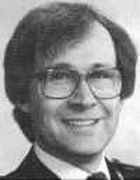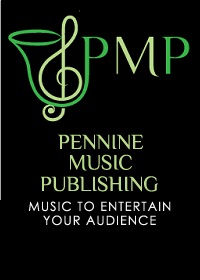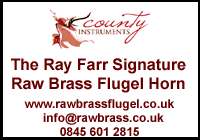2008 English National Championships - Test Piece Review
24-Jun-20084BR has a look at Robert Redheads set work Infinity' and wonders whether or not it will be ...and beyond any of the conductors and their bands on the weekend.
 Over the last decade or two contest organisers have repeatedly commissioned the same small circle of composers for their competitions. The likes of Wilby, Graham, Sparke et al, have been used many, many times, and some would even say they have now almost reached the point of overuse.
Over the last decade or two contest organisers have repeatedly commissioned the same small circle of composers for their competitions. The likes of Wilby, Graham, Sparke et al, have been used many, many times, and some would even say they have now almost reached the point of overuse.
It is a major disappointment to some observers that with a new generation of exciting young composers at their disposal, a major contest such as the English National hasn’t as yet taken the opportunity to showcase their talents.
Skill
Having a high profile and reputation does of course help in pulling in a large audience, but there have been many cases in the past few years of examples of test pieces that have lacked imagination and the kind of skill demonstrated by the aforementioned triumvirate, which has in turn, led to the elevation of the average, and handed triumph to the bland.
And whilst there is considerable merit in contest organisers turning to Salvationist composers, there is also a feeling that in doing so, so readily at times, perhaps the movement is missing a real opportunity in exploring a new and potentially exciting compositional direction.
Welcome
Welcome as much of their compositional output undoubtedly is, the genuine question arises to whether or not we are moving on a somewhat constrained conservative musical path.
Perhaps Robert Redhead’s ‘Infinity’ may reveal if such impressions are accurate or not.
After Sparke and Graham in the past two years, the English National has commissioned a composer whose most famous work, ‘Isaiah 40’, was used at the 1996 National Finals as well as the 2007 Area contests.
Inspiration
As perhaps expected, his new composition, entitled, ‘Infinity’, draws inspiration from the bible and specifically the interpretation by Eugene Petersen of Psalm 8 – a Psalm of David to the Chief Musician upon Gittith.
This itself describes the majesty of God’s infinite creations - from suckling babies to the moon and stars, the beasts of the field, the fowl of the air and the fish of the sea: “O Lord our Lord, how excellent is they name in all the earth!”
Petersen’s updated interpretation is more lyrical in its poetic language, although the context remains the same: “God, brilliant Lord, your name echoes around the world.”
Infinite quality
For the composer, Psalm 8, “creates a great picture of the majesty, eternal, infinite quality of God, and yet reveals the desire of God to share in spirit with humankind. It recognises humankind as being, not a tool of the infinite, but as a creative contributing part of the ongoing movement and activity of the infinite.”
Whether or not those performing the music share those sentiments and beliefs is a matter for discussion at another time perhaps, but the melodic nature of the composition certainly allows for a great deal of interpretive scope.
In his performance notes to accompany the work, Redhead himself states; “The opening theme offers an opportunity for the conductor to fully explore the expressive melody and underlying harmony”, whilst by its end, the performances he hopes should display an expressed ‘…magnificence, with poise and stateliness, followed by a quite confidence in the meaning of the absolute, infinity itself.”
Asking a great deal
In anyone’s understanding and beliefs, that is asking a great, great deal from a brass band test piece of around 12 minutes or so in duration. You cannot pin the badge of musical conservatism on that can you now.
Regardless of any composers programme note, and the story they have chosen to tell through their composition, a composer’s job first and foremost is to create a sound musical composition.
‘Infinity’ opens with a hymn-like tune (which provides the main thematic material of the piece) in the horns, accompanied by a baritone, euphonium and Eb bass. This quiet setting is sounded by the solo and first horns, although the keen contest goer should keep an eye out for bands trying to get away with just the solo horn performing the melody.
Chorale
The section opens out in a chorale-like fashion, adding flourishes in the euphoniums, baritones and horns, before lilting up a semitone, complete with rising scalic passages. Repeating the tune, this time with various instruments in the band performing the flourishes, the composer leads us to a ferocious climax, before a quiet reprise of the original setting.
Whilst these flourishes and scalic passages are technically tricky for the players, it will be interesting to hear if the effect has the clarity required to pull off the composer’s intentions.
Momentum
Following this quiet conclusion is a 12/8 Scherzando, marked dotted crochet equals 168. The soprano cornet opens, initially alone, before temple blocks enter, followed by the rest of the cornets – sometimes in unison, sometimes, not. The motif (which is basically a quicker version of the opening) works its way downwards through the band, before the composer builds us nicely into the next section, creating forward momentum with more (and quicker) technical work.
This whole 12/8 section really hurtles through at some pace – one that some, if not many of the bands, could find very difficult to play at the composers’ indicated tempo.
A return to the initial tempo follows, in a slightly developed version of the hymn tune, set as a flugel solo. As with the opening section, flourishes start to decorate and the section winds down. This is followed by an elegant passage in 6/8, linking the composition into a 4/4 Giocoso.
Latin dance
This Giocoso is percussion lead, mainly by the bongos, in a rhythmic accompaniment, which the average brass band enthusiast is more likely to have heard more readily on the Latin dance part of ‘Strictly Come Dancing’ rather than as part of an important test piece!
The composer, perhaps intentionally, has neglected to dovetail most of the lines the horns exchange and interchange; the bands who want to achieve success in this section will no doubt be hastily rewriting this in Sibelius in order to achieve good continuity and flow to the music – it would be a mistake however, as it will rob the detail and texture of the individual voices to be heard.
Substantial challenge
Again the composer decorates with tempting filigree work to move it forwards to another new section – a rhythmically punchy brilliante, mixed with a sprinkling of the previous sections’ Latin flavour and bravura technical hurdles.
There is also quite a substantial challenge for the soprano cornet, who has some very tricky solos to play here, as well as other leading solo voices – at times in unison.
A variation on the original hymn follows – a soprano cornet solo accompanied by trombone trio (marked con espress). This gives way to a small horn duet, again underpinned by the trombones, before the band joins in and gives way to another extended element – a developed, loud, reprise of the earlier 12/8 section. This is so short though that should you proverbially blink, you may miss it!
Impossible to achieve
Its end signals a return to the original chorale – this time with the band at fortissimo. The decoration comes from the middle of the band, although the balance – at least on paper – looks almost impossible to achieve even for the very best bands using the composers’ dynamics. Some tweaking may be needed to hear the underlying flow from horns and xylophone.
Conclusion
The section dwindles in dynamic and tempo at its conclusion, before one last setting of the original hymn, this time for the whole band. The combination of a quiet dynamic and a continuous rallentando brings the piece to a quiet, peaceful, conclusion, which strangely sees the instruction niente (to nothing) used – not quite as infinite then as perhaps intended.
At the opening of this review, it was stated that a composer’s job, first and foremost, was to write a sound piece of music. In truth, when composing a work for a contest the job is, more than anything else, to write a good test piece.
Test
Infinity will, without doubt, test the bands to their extremes – and maybe even beyond (to coin Buzz Lightyear’s favourite phrase)– and also asks much from the conductor, although the challenges they face aren’t always musical ones.
The work will separate the good from the poor, the skilled from the not so skilled and the best bands (and the best soprano cornet players) will need to be at the very top of their game to overcome it. It also has an instantly recognisable melody – something for the audience to enjoy immediately in each performance.
Reflection
Although on the subject of the audience, with the quiet end to this piece, they are robbed (deliberately it must be said) of their immediate chance to get involved in the theatre of contesting, and will have to save their applause, cheers and screams, until the silence after the last note has died. It may give the hotter headed out there essential time for proper reflection on what they have heard.
Given the biblical background to the work, that perhaps is the essence of its inspiration.















